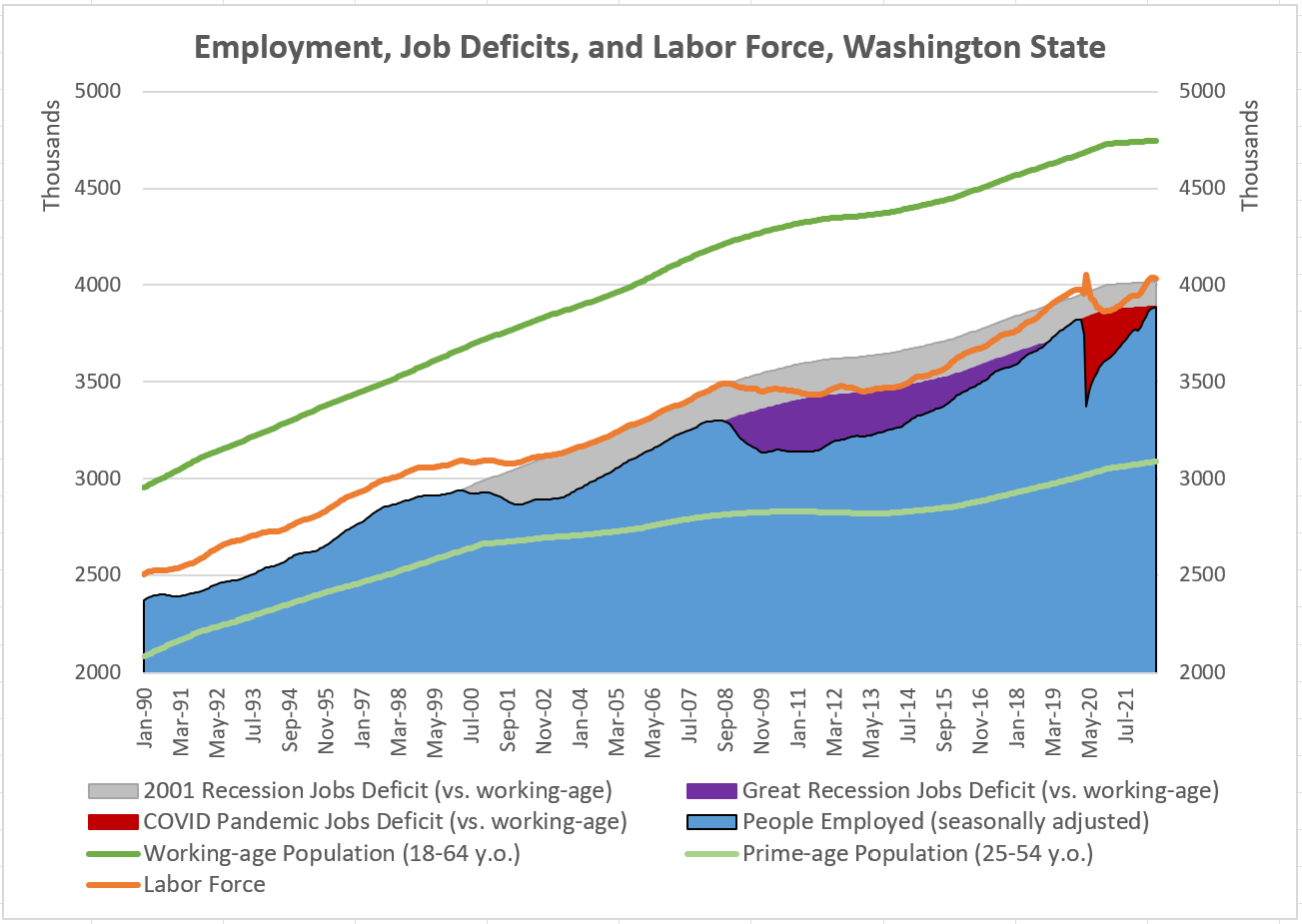More than 30 months since the pandemic began, COVID is still with us. While (from a jobs point-of-view) its biggest economic shock waves have subsided, some of its effects still linger. Here’s what Washington’s jobs picture looks like now — and a lesson we can learn from the public policy response to the pandemic.
Unemployment continues to decline
Washington’s seasonally adjusted unemployment rate fell to 3.7 percent in July, eclipsing its Feb. 2020/pre-COVID low of 3.9 percent. Nearly all of the state’s major metropolitan areas have followed a similar trend — and the state’s underemployment rate (which includes discouraged, marginally attached, and involuntary part-time workers) is now just half a percentage point above its pre-COVID level.

The jobs deficit is shrinking
In other good news, Washington’s job growth has been strong enough to not only gain ground on pandemic-related job losses, but also to absorb much of the increase in the state’s working age population (age 18-64) since the pandemic began. The state’s COVID jobs deficit — which accounts for both factors — stands at 8,156 in July. While that’s an increase from June (when the gap was just 4,968) it’s still possible the jobs deficit could be entirely erased by year’s end.

Source: Author’s calculations based on data from Washington State Office of Financial Management and Washington State Employment Security Department.
Looking at jobs alone, Washington first exceeded its pre-COVID total back in April — but by just 4,000 jobs. While the pace of job growth has been somewhat flatter since, July’s numbers put the state at 14,400 more jobs overall than in Feb. 2020. That counts as real progress.
The local picture is more nuanced. While Seattle is the state’s largest jobs market, as of July it is still 12,500 jobs shy of its pre-COVID jobs total — though to be fair, it also had far more ground to make up than other localities. Other areas which haven’t yet fully recovered all jobs include: Tacoma (-1100), Mt. Vernon (-2700), Bellingham (-2800), and Bremerton (-2900). Meanwhile, Wenatchee stands exactly at the breakeven point (having recouped jobs lost, but with no net gains so far), and a handful of metro areas have posted net increases, including: Yakima (+700), Longview (+1500), Olympia (+2300), Kennewick (+3200), and Spokane (+6300).

Sectors driving (and lagging) job growth
The sectors leading job growth in Washington (measured by net employment change since February 2020) are: Information (+23,700/+15.9 percent), Professional, Scientific, and Technical Services (+22,500/+10.2%), Construction (+14,000/+6.3 percent), and Admin. and Waste Mgmt. Services (+12,900/+7.2%). These same sectors have also largely returned their pre-COVID pace of job growth.
In the middle of the pack are: Retail Trade (+4800/+1.2%), Health Care and Social Assistance (+2800/+0.6%), and Wholesale Trade (+2800/+2.1%). With the exception of Wholesale Trade, the pace of growth in these sectors has not returned to pre-COVID levels.
The sectors which are most lagging include: Accommodation and Food Services (-10,800/-3.7%) State Government (-12,800/-8.5%), Local Government (-13,900/-3.8%), Other Services (-14,100/-10.6%), and Manufacturing (-21,000/-7.2%). With the exception of Accommodation and Food Services (which is showing strong job growth), these sectors are either continuing a period of pre-COVID decline, or the pace of job growth is significantly slower than in other sectors.

Another way to look at Washington’s jobs picture is by total job composition among the same 12 largest job sectors. Measured this way, job growth or decline is now largely tracking with pre-pandemic (end of Great Recession to start of COVID pandemic) trajectories. The only significant exception is Accommodation and Food Services, which was the sector perhaps most deeply impacted by the pandemic.

Source: Author’s calculations based on data from Washington Employment Security Department
Jobs recovery was not automatic
The COVID-19 pandemic has touched nearly every facet of people’s lives — and at its height, dramatically altered the shape and scope of Washington’s economy. But absent strong federal, state, and local public policy choices meant to support workers, families, and businesses, we almost certainly wouldn’t have the jobs recovery we do today.
By putting billions of dollars in workers’ collective pockets — and providing billions more in loans (many of which became grants) to businesses, direct federal aid sustained our economy at a time when the bottom was quite literally falling out of the jobs market. Because workers had the means to buy, businesses had customers and could keep their doors open. Eviction protections for renters, assistance with childcare, and hazard pay for workers on the front lines are just a few of the many other policy and spending choices that helped protect all of us from the worst economic effects of the pandemic. (And of course, federal leadership enabled development of the COVID vaccines we have today.)
While the jobs landscape has improved greatly over the past 12 months, in many of the state’s largest sectors, it remains to be seen what, or whether this, is the new “normal”. If there’s a single lesson we can draw from our experience thus far, it’s this: public policy decisions (and public investments) made by our lawmakers are a powerful tool for shaping our economy and our communities for the better — and we shouldn’t wait for a crisis to act on that.
More To Read
August 10, 2021
New State Programs May Ease a Short-Term Evictions Crisis, but Steep Rent Hikes Spell Trouble
State and local lawmakers must fashion new policies to reshape our housing market
November 20, 2020
We Can Invest in Us
Progressive Revenue to Advance Racial Equity



